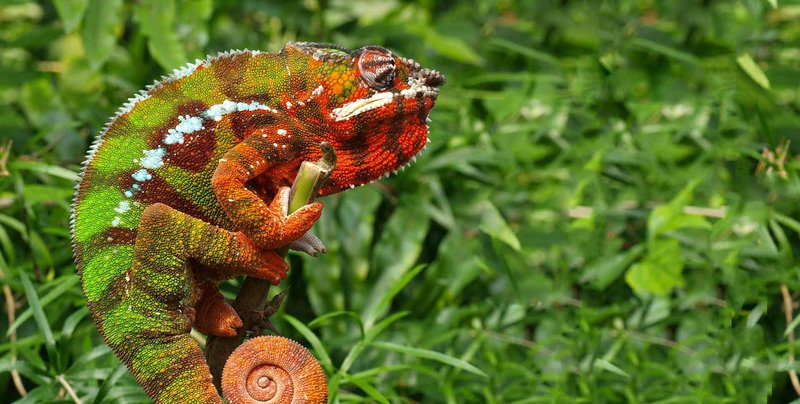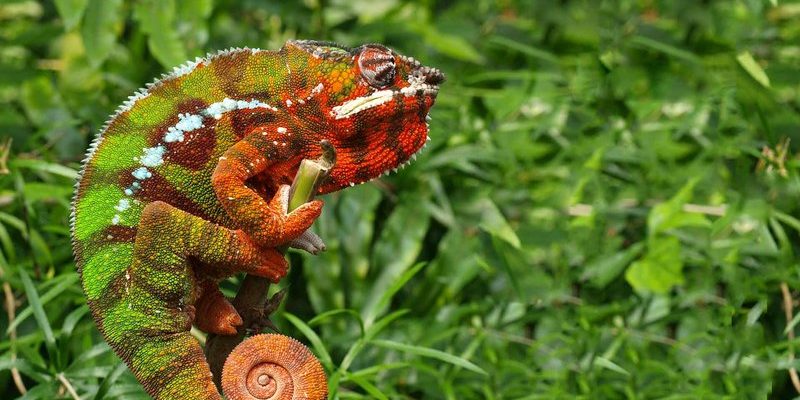
Imagine wandering through a lush jungle, feeling the warmth of the sun on your skin while a cool breeze ruffles the leaves. That’s the environment you want to recreate for your chameleon. With the right temperature and humidity levels, your pet can truly flourish. Let’s dive into the specifics of what your chameleon needs to stay vibrant and active!
Understanding Temperature Requirements
When it comes to temperature, panther chameleons are pretty particular. In the wild, they bask in heat during the day, taking full advantage of the sun’s warmth. Ideally, you want your chameleon’s environment to mirror this natural habitat.
During the day, the basking spot should be around 85°F to 90°F. This gives them a warm place to soak up the heat. You can achieve this with a basking lamp that focuses the heat in one area of the tank. Make sure to place a thermometer near this spot to monitor the temperature accurately. You might be wondering how you can tell if your chameleon is too hot. If you catch them spending too much time away from the basking area or trying to hide in shadowy places, it could be a sign they’re feeling overheated.
At night, temperatures can drop a bit. Aim for around 65°F to 75°F during the cooler hours. It mimics the natural temperature fluctuations they experience in the wild. Avoid using heat mats, as these can heat the substrate rather than the air, leading to uneven temperatures that can stress your chameleon.
Creating Temperature Gradients
One effective way to keep your chameleon happy is to create a temperature gradient in the enclosure. This simply means having one side of the tank warmer and the other cooler. Think of it like a little island of sun and shade—perfect for your chameleon to choose how hot or cool they want to be.
To set this up, position the basking light on one end of the tank, while leaving the other side more open for airflow. This allows your chameleon to move freely between areas, helping to regulate their body temperature naturally. It’s almost like giving them the choice to lounge on a sunny beach or relax under a shady tree!
The Importance of Humidity
Humidity is another critical factor that influences the wellbeing of your panther chameleon. In their natural habitat, humidity levels range from 50% to 70%. This moisture helps them stay hydrated and supports their skin and shedding process. Too low humidity can lead to shedding problems and dehydration, while too high can encourage respiratory issues.
You can monitor humidity levels with a hygrometer, which gives you a clear reading of the moisture content in the air. If you find that your humidity levels are consistently too low, consider increasing misting or adding a small humidifier to the tank. It’s important to find that sweet spot—think of it like balancing a hot drink; you want it warm enough to enjoy but not so hot that it burns!
Methods for Maintaining Humidity
So, how do you keep that crucial humidity level just right? Start by misting the enclosure regularly. A good rule of thumb is to mist it once or twice a day. This not only raises humidity but also provides fresh water droplets for your chameleon to drink.
Another option is to use a drip system, which slowly adds water to the tank over time. This method is especially useful if you have a busy schedule and can’t mist as often. Just ensure that excess water doesn’t accumulate on the substrate, as this can lead to unwanted mold growth.
Lastly, consider adding live plants to your chameleon’s habitat. Plants help retain moisture and give your chameleon places to hide and climb. Plus, they make the enclosure look more appealing, adding a splash of green to your vibrant pet’s home!
Adjusting for Seasonal Changes
As seasons change, so do environmental conditions. If you live in an area with distinct seasons, you’ll need to adjust your temperature and humidity settings accordingly. For example, winter can make indoor air dry, so your chameleon may need extra humidity during those months.
Keep an eye on your hygrometer; if it starts to drop below that ideal range, boost humidity levels with more frequent misting or a humidifier. Conversely, if you find it getting too humid, you may want to reduce misting a bit or increase ventilation.
Here’s the thing: know your chameleon’s behavior! If they seem lethargic or are not eating as much, it might be worth checking the environmental conditions inside their habitat. They’re pretty good at telling you when something isn’t quite right.
Signs of Improper Temperature and Humidity
It’s crucial to be aware of the signs that your panther chameleon is uncomfortable due to improper temperature or humidity. For instance, if you notice your chameleon becoming less active, hiding more often, or having difficulty shedding, these could be indicators of environmental stress.
Strong signs of dehydration include sunken eyes or a sticky tongue that has difficulty capturing prey. If you see these symptoms, it’s time to reassess your humidity levels. Similarly, if your chameleon is constantly trying to escape their enclosure, it might be too hot or too humid for their liking.
Regularly observing your chameleon’s behavior can give you valuable insights into their well-being. Remember, a happy chameleon is an active one, full of those stunning colors that make them so unique!
Creating the perfect environment for your panther chameleon takes some attention and effort, but it’s well worth it. By understanding their specific temperature and humidity needs, you can provide a habitat that keeps them happy and healthy. Just imagine how rewarding it feels to watch your colorful companion thrive in a space that mimics their natural home.
Remember to adjust the temperature throughout the day, maintain appropriate humidity levels, and be mindful of any seasonal changes. With a bit of patience and the right setup, your chameleon will bring joy and beauty into your life for years to come. So, grab that thermometer and hygrometer, and let’s make your chameleon’s home a vibrant oasis!

